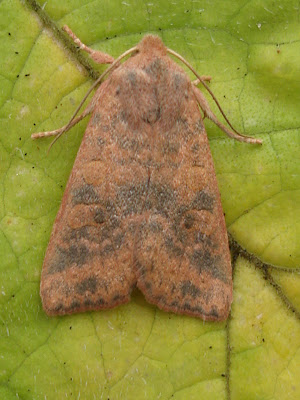 Called round to David Cooper's house in West Mersea on Thursday 23rd, to be shown this monster of a caterpillar of a death's head hawkmoth. The caterpillar had been found crossing a garden lawn in Beach Road in West Mersea and was passed onto David, who in turn passed it onto me.
Called round to David Cooper's house in West Mersea on Thursday 23rd, to be shown this monster of a caterpillar of a death's head hawkmoth. The caterpillar had been found crossing a garden lawn in Beach Road in West Mersea and was passed onto David, who in turn passed it onto me.The moth is a very rare visitor to Essex and the discovery of this caterpillar on the Island means that there was an adult female flying about West Mersea undetected earlier in the summer. I've never seen either the moth or the caterpillar before, so I was very excited to see this one in the hand. The death's head hawkmoth is the largest moth to be seen in the UK and the same goes with it's caterpillar too.
The caterpillar is unmistakable due to its size and markings with this one reaching in length to four inches (10cms). In the photo above the caterpillar shows the small yellow horn at the rear end (top in photo) and the pretty bluey-green diagonal stripes along the side of the body.
The caterpillar was given a small selection of leaves ranging from tomato, privet, buddleia and some lettuce. However the original discovery of this caterpillar away from its foodplant suggests that it was ready to pupate. After a quick read up on the internet, I filled up a large perspex box with soil, placed the caterpillar onto it and covered the box over with fine netting for the night. By the next morning, the jolly green giant had disappeared from view and had presumably burrowed down ready to spend the next few weeks turning itself into an adult moth.
I shall be keeping a close eye on the box in a month's time, and fingers crossed - I could be a proud dad! I read a comment on the web that every keen moth enthusiast should try rearing a death's head hawkmoth at least once!
The moth trap was checked on Thursday morning where a still and cool night had resulted in a lower turnout for moths. This dusky-lemon sallow pictured above, was the most interesting as it has a scarce distribution in Essex because of the decline in the elm, the foodplant of the larvae. One or two individuals are normally recorded here at the park each autumn.
 This orange sallow has a similarly scarce status in Essex to the dusky-lemon sallow, so it was nice to see this recorded again at the park. Last year it was noted on a couple of dates in the third week in September, so a similar time of the year.
This orange sallow has a similarly scarce status in Essex to the dusky-lemon sallow, so it was nice to see this recorded again at the park. Last year it was noted on a couple of dates in the third week in September, so a similar time of the year.
Nineteen species involving about 70 individuals included the brick, flounced chestnut, frosted orange, black rustic, beaded chestnut, brindled green and L-album wainscot.
Birdwise at the park two goldcrests were still foraging with the tits beside the car park for the third day. A few swallows and meadow pipits passed over the park during the day.
Martin Cock saw a late turtle dove at Maydays farm on Thursday and 2 late swifts over West Mersea at the beginning of the week.



2 comments:
Hi
Fantastic find,never seen a wild deaths head,keep the pupa cool and fairly dry and you may be realy lucky.
I'm certainly going to be waiting anxiously to see if it's found the conditions suitable. Only time will tell! Hope there will be some pictures to show later!
- Dougal
Post a Comment